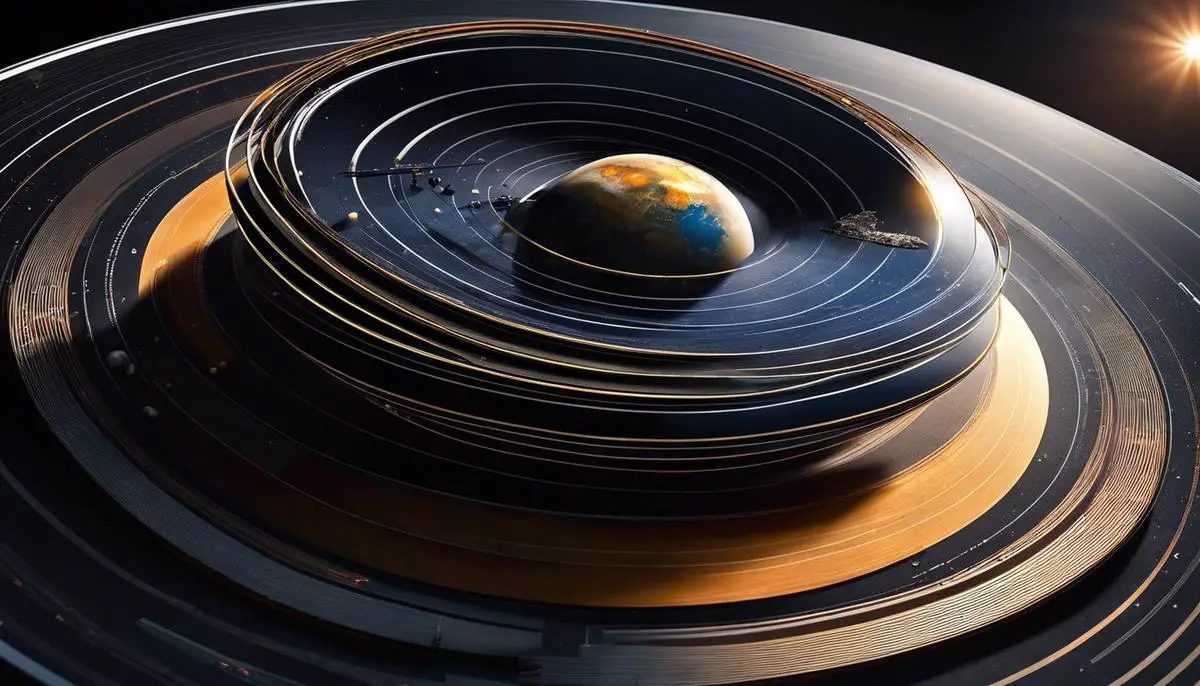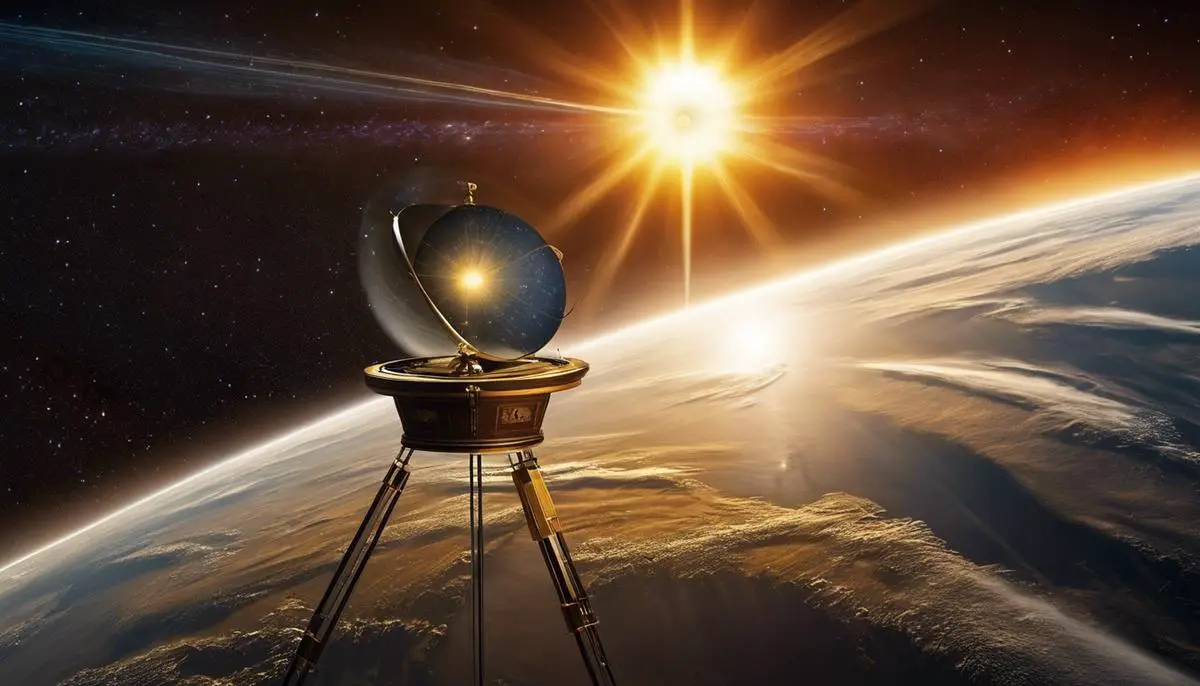The sphere of human knowledge has forever been in a ceaseless state of expansion, fueled by inquisitiveness and the never-ending quest to unravel the secrets of the cosmos. Among the many wonders that have intrigued mankind, the relationship between our sapphire planet and its dazzling source of energy – the Sun – has held an enduring fascination. From the resourcefulness of ancient Greek astronomers to the cutting-edge technologies of the modern era, the pursuit of an accurate Earth-Sun distance measurement has been a testament to human ingenuity. This exploration has journeyed through many crucial phases of history, bearing witness to the advent of the Astronomical Unit, the extraordinary phenomena of Venus transits, the revolution of radar ranging, and the continuing refinements instigated by advanced techniques. This story of humankind’s relentless pursuit is a symbolic reflection of our desire to comprehend our place in the universe.
Greek Origins
Ancient Greek Astronomers and Estimation of Earth-Sun Distance: A Voyage of Cosmic Proportions
From the earlier days of human civilization, the quest to understand the cosmos has been innate and relentless. This profound interest manifestly found a home in Ancient Greece, where scholars reached groundbreaking advancements, particularly in the world of astronomy.
A striking example from this epoch is the delicate task of measuring the Earth-Sun distance, often referred to in scientific terms as the Astronomical Unit (AU). This quest faced numerous hurdles due to the lack of modern technological advantages we enjoy today, but ancient Greek astronomers ingeniously overcame these challenges with admirably high precision.
Eratosthenes, the head librarian at the Library of Alexandria and an eminent geographer during the third century B.C., spearheaded the charge. His approach ingeniously combined mathematical knowledge with astute observation of the physical world’s phenomena to arrive at an approximate measurement of this cosmic distance.
To comprehend the method employed by Eratosthenes, one must first understand the concept of ‘solar noon’, the time at which the sun is highest in the sky at a given location. By measuring the angle at solar noon in two different sites — Alexandria and Syene — Eratosthenes proposed that the angle difference was proportional to the distance between the two locations. Furthermore, utilizing his geographic knowledge, he calculated this distance and subsequently determined the Earth’s circumference.
This accomplishment, monumental as it was, served as a stepping stone to deciphering the Earth-Sun distance. Aristarchus of Samos, another renowned Greek astronomer, implemented observation of lunar eclipses and employed simple geometric principles to estimate this cosmic distance.
During a lunar eclipse, the Earth casts a shadow on the moon. Aristarchus identified that this shadow was roughly two lunar diameters, thus deducing that the Earth must be about three times the size of the moon. Using Eratosthenes’ measurement of the Earth’s circumference, Aristarchus then estimated the moon’s distance from the Earth.
To calculate the Earth-Sun distance, Aristarchus observed the moon at its first quarter phase. At this moment, the Earth, moon, and sun form a 90-degree triangle. With estimated values for the Earth-moon distance, Aristarchus could then apply the principles of basic geometry to provide an estimation of the Earth-Sun distance.
While the numbers obtained by Aristarchus were not accurate as per modern standards, the methodology employed was remarkably intelligent and a paramount testament to the heightened observational skill, mathematical prowess, and intellectual curiosity of these astronomers from ancient Greece.
The endeavors of these Greek astronomers stand as a significant testament to human ingenuity in probing the depths of the cosmic scape. Their trailblazing efforts paved the way for future advancements in astronomy, laying a solid foundation for the astronomical sciences that continue to evolve and answer the mysteries of the cosmos.
Therefore, let’s acknowledge and appreciate the enormous strides these astronomers took, not just for the knowledge of their time but also for subtly kindling the spark of curiosity that led us to explore beyond the confines of Earth and venture into the vast expanse of the universe. The essence of their work continues to reverberate through the corridors of modern astronomical research, truly embodying Isaac Newton’s famous sentiment, “If I have seen further, it is by standing upon the shoulders of giants.” Their work is not just a chapter in the annals of astronomy, but a symphony of science that still resonates across millennia.

The Astronomical Unit
Having set a historical backdrop with ancient Greek astronomers’ remarkable contributions in measuring Earth-Sun distance, let us turn to the significance of an established term in contemporary astronomy – the Astronomical Unit (AU). Derived from these early endeavors in astronomy and improved over centuries, this unit has presented substantial advantages for studying and understanding the universe.
The Astronomical Unit is defined as the average distance between the Earth and the Sun, approximately 93 million miles or 150 million kilometers. In the precise language of astronomy, one AU is defined as the length of the semi-major axis of Earth’s elliptical orbit around the Sun.
What sets apart the Astronomical Unit as pivotal is its utility in facilitating astronomical measurements within our Solar System. The extraordinary distances in astronomy are cumbersome to measure, and even more so to comprehend. Utilizing AU presents these otherwise overwhelming distances in a more tractable form. For instance, the planet Mars is about 1.52 AU from the Sun, and Jupiter is about 5.2 AU away. These measurements offer an immediate sense of proportion relative to the Earth-Sun distance.
Moreover, since the values expressed in AU are dimensionless and independent of any particular observer’s location, this unit provides a degree of simplicity and universality that individual global measurement systems cannot. This was evident especially during an era when the exactness of values like the kilometer or mile was not yet established.
The Astronomical Unit also serves a crucial role in the study of celestial bodies’ movements within our Solar System, commonly known as celestial mechanics. When one considers the orbits and gravitational interplay of planets, asteroids, and comets, AU offers a handy measure for calculations.
The concept of the Astronomical Unit also encourages a broader understanding of the vastness of our cosmos. It offers a stepping-stone to deal with larger units, like the light-year and the parsec, that accommodate the enormity of the universe beyond our Solar System, serving as an elemental rung in the cosmic ladder of distance.
Indeed, the Astronomical Unit is a tribute to the ingenuity and perseverance of astronomers who have endeavored to measure and map the cosmos, from Eratosthenes to present-day scientists. That such a unit can translate the unfathomable distances of the universe into digestible numbers is a testament to the power of human scientific progress. Today, this legacy continues, while understanding and harnessing the Astronomical Unit remains foundational in the attempt to unravel the Cosmos, fostering vital perspectives towards the boundless mysteries beyond our Earth.

Transit of Venus
Building upon the foundational work of the ancient Greeks, the study of Earth-Sun distance encountered a turning point with the observation of phenomenon known as the Transit of Venus. The exact reasoning behind utilizing this astrological event to ascertain the Earth-Sun distance relies much on the principle of parallax – a geometric technique exploited to measure large distances.
Simply put, parallax is the apparent shift of an object’s position when observed from two different vantage points. To use an everyday analogy, extend your arm and view your thumb with one eye open, then with the other – your thumb will appear to move against the background, even though it stays still. This movement demonstrates the parallax effect.
Leveraging parallax’s ability to render measurable distance to far-off objects, astronomers of the 18th and 19th centuries turned their attention to the Transit of Venus across the solar disc. The venture was by no means an ordinary observational event. To record this crucial transit, brave souls equipped with telescopes ventured into uncharted terrains from Arctic to Pacific, eager to capture this rare occurrence.
When Venus crosses the face of the Sun, the time it takes to traverse, along with the perceptible difference in the planet’s path as viewed from different locations on Earth, provides the basis for calculating solar parallax.
By employing a simple, yet unbelievably powerful piece of trigonometry, it’s possible to use the measured parallax angle to compute the actual distance of the Earth from the Sun. This calculation results in one Astronomical Unit (AU), which stands as a fundamental ‘yardstick’ for cosmic scales within our solar system.
The measurement established from the Venus Transits in the 18th and 19th centuries, though not perfectly accurate, led to a more refined value of the solar parallax. Furthermore, once scientists obtained this vitally important number, they could then use it in conjunction with Kepler’s Laws for celestial mechanics to measure other distances in the Solar System.
This constant of solar parallax, derived from the venturesome efforts of astronomers observing the Transit of Venus, remains significantly impactful in the field of astronomy. Beyond serving as the cornerstone of the Astronomical Unit (AU), it provided humanity with the first scientifically established scale of the universe.
In essence, the foundation laid by the likes of Eratosthenes and Aristarchus of Samos, coupled with the modern determination of solar parallax as unveiled by Venus’s transit, encapsulate the Herculean efforts by the scientific community. This collective wisdom has given humanity a sense of place in this enormous cosmic gallery and continues to provide milestones for the future unraveling of the universe. The foundling effort to measure the Earth-Sun distance has progressed to now measuring the farthest realms of Cosmos with precision and accuracy. Therefore, the contributions of solar parallax and the AU tap at the core of astronomical sciences and the study of celestial bodies, holding the promise to facilitate further celestial discoveries.

Radar Ranging
Following the groundbreaking work of the Ancient Greeks, the mid-18th century embarked upon a momentous event that established another milestone in measuring the Earth-Sun distance.
This pivotal event was the transit of Venus across the face of the Sun. Employing the principle of parallax – a displacement or difference in the apparent position of an object viewed along two different lines of sight – astronomers seized the opportunity to measure the Earth-Sun distance with unprecedented precision. Parallax, essentially, provides a geometric method to ascertain immense distances in astronomy.
Here, scientists harnessed the power of trigonometry, a branch of mathematics that deals with the relationships between the sides and angles of triangles. During the transit of Venus, the planet Venus traversed between the Earth and the Sun, providing a rare chance to calculate solar parallax – the difference in the apparent position of the Sun when observed simultaneously from the Earth’s two diametrically opposed points.
This calculation led to a more accurate determination of the Astronomical Unit (AU), a term conceptualized to describe the Earth-Sun distance. The AU, thus, became a fundamental unit of measurement in celestial mechanics – the branch of astronomy that deals with the motions of celestial bodies under the influence of gravitational fields.
The endeavor to understand AU better proved significant in exploration of the universe as it allowed for more accurate measurements within the Solar System. The dimensionless and universal nature of AU made it not just a cornerstone for measuring celestial bodies’ movements, but also served as a stepping-stone to larger units of measurement in the cosmos, such as the light-year and parsec.
Unveiling the curtain of cosmos is a journey marked by the ingenuity and perseverance of curious minds through history. Every calculation, from the genius of Ancient Greek astronomers to the methodical science of later centuries, tells a story of unwavering pursuit of knowledge. The concept of measuring Earth-Sun distance, the transit of Venus, and harnessing the power of AU, have all had their roles in chiseling our understanding of the universe.
The precision provided by solar parallax further paved the way for calculations of other distances within the Solar System, thereby playing a significant role in celestial mechanics. This revolutionary shift in measurement precision also directly impacted the field of astronomy, elevating our understanding of the cosmos to another level.
Fast-forward to the 20th century, as technology made prodigious strides with the advent of the radar – the technique using radio waves to determine the distance, angle, or velocity of objects. This novel technology offered even more precision in determining the Earth-Sun distance. Scientific advancements and introduction of radar-ranging, led to one of humanity’s most astounding moments in the holy grail of astronomical sciences: the chance to pinpoint the Earth-Sun distance with extraordinary, near-perfect accuracy. An ingenuous twist of invention and scientific knowledge, the usage of radar dramatically revolutionized the way we comprehend our position in the solar system.
Undeniably, the advent of radar ranging marked a significant leap from the parallax method, outplaying previous limitations and offering incredible exactness. Reveling in this realm of precise knowledge not only enriched our understanding in scientific terms, but also painted a more vivid portrait of our cosmic neighborhood. It served to gratify the curiosity kindled by our forethinkers; their flame of inquiry illuminating the way for ours into this eternal quest to fathom the infinite cosmos.

Modern Techniques and Refinements
The Spirit of Modern Astronomical Measurements
From the era of ancient Greeks who first scribbled the blueprints of our understanding of the cosmos, we have continually refined methods for exploring our place among the stars. A focus point of such advancements rests on the Herculean task of ascertaining the daunting distance that separates Earth from its resident star, the Sun.
In the wake of historical ancient astronomers, a significant milestone unfolded with the transit of Venus. This celestial phenomenon occurs when Venus, our nearest planetary neighbour, passes directly between the Earth and Sun. Observed across disparate geographical locations on Earth, this transit offered a unique opportunity for measuring the Earth-Sun distance. This emerged from the principle of parallax, which describes a perceived movement of an object relative to distant background stars, owing to a change in the observer’s position.
Harnessing the transit of Venus, scientists employed trigonometry to calculate the solar parallax—the angle subtended by Earth’s equatorial radius when observed from the Sun. As a brainchild of this endeavour, the Astronomical Unit was born, serving as a yardstick to represent the enormous Earth-Sun distance. Today, this fundamental unit fuels engines of celestial mechanics, guiding us in mapping the sprawling celestial paths traced by resident bodies of our Solar System. That’s not all — this unit salutes the merit of dimensionless entities, embracing universal validity, and offering a critical stepping-stone for dwarfing interstellar and galactic distances.
Yet, the quest for accuracy in embracing the scale of the universe never wanes. As astronomers brushed their hands against the technological march of time, radar technology entered the scene. Radars gifted astronomers with the capability to bounce radio waves off planets like Venus or Mercury and record their echo. This time delay spilled the secrets of the planets’ distances, thereby refining our knowledge of the Earth-Sun distance with precision.
Within the confines of modern astronomy, such progressive refinement of measuring techniques brews a revolution. In paying tribute to the perseverance and ingenuity of astronomers across the epoch, the intricately woven story of our quest to glance beyond the terrestrial confines comes alive. From the laurels of Ancient Greek observations to the vaulting heights of radar technology, the understanding and mastery of the Earth-Sun distance has evolved, thrusting us further into the enigma of the cosmos.
As we continue deciphering this cosmic mystery, the art of measuring distances remains a testament to human curiosity and the ceaseless quest to prod the vast seas of the unknown. At this juncture and age, we stand at the epitome of technological advancements and enlightenment, having come far from the rudimentary shadows of ancient observations, to embrace the golden era of modern astronomical pursuits.

It is evident that the journey to understand how far we truly are from our life-giving star has been a rich tapestry of human ingenuity and perseverance through the ages, involving methodologies as diverse as the cultures in which they were conceived. Each measuring technique, from the first rudimentary stargazing to the advanced technologies employed by the likes of NASA, has further refined our understanding. The culmination of these efforts is a precise measure of the Earth-Sun distance, a figure that provides a fundamental basis for spatial understanding in astronomy. Yet, with each new discovery unfolds another layer of cosmic mystery, reminding us that as long as the stars scintillate in the night sky, our pursuit of knowledge will remain as boundless as the universe itself.
![]()
